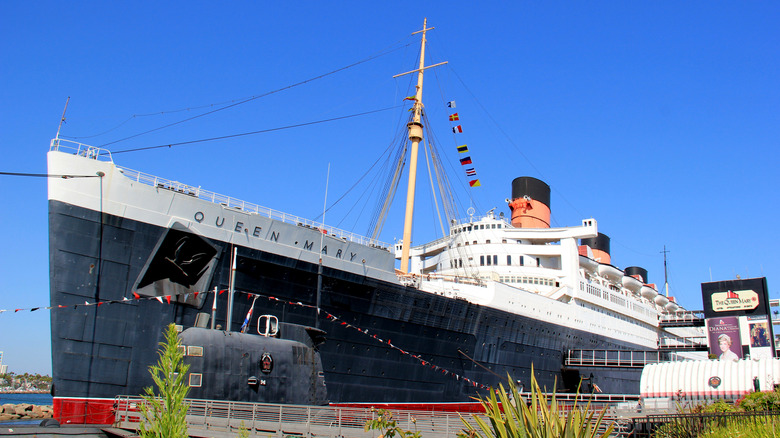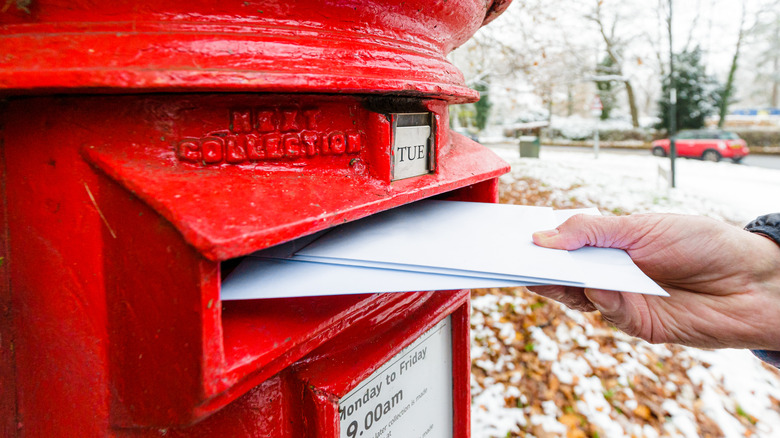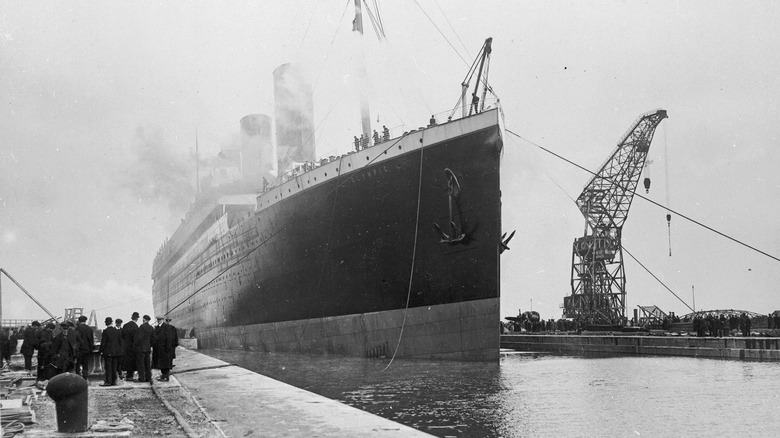What Does RMS On A Ship Mean?
We've all heard those double or triple letters before ship names, right? Like the HMS Pinafore (a Gilbert and Sullivan opera), the RMS Titanic (the big, famous ship that sank), and the USS Enterprise (the starship manned by Captain Kirk). Plus there's SOS, which isn't a prefix but Morse Code that many mistakenly take to mean "save our souls" or "save our ships." Then there's plain old SS, an acronym for "steamship." "SS" was the first such ship prefix back in the 1800s when steamships took off as cutting-edge travel and shipping technology. And we mentioned "RMS." That's because the Titanic, in addition to ferrying 2,240 passengers, held between 6 to 9 million pieces of mail when it sank. That's because the Titanic, like all RMS vessels, was a delivery ship. "RMS" means "Royal Mail Ship."
Starting with the very first passenger-carrying steamship in 1807, the Clermont by American engineer Robert Fulton, steamship production and proliferation soared through the 19th century. By 1836, we saw the first transatlantic passenger steamship, the SS Great Western. Note the prefix "SS," which the Clermont didn't have. At this point, ships started getting prefixes based on roles and types, particularly steamships. Examples include designations we mentioned before, like "HMS" for His/Her Majesty's Ships, a prefix reserved for the British Royal Navy. Then there's "RMS," which also comes from the United Kingdom and means precisely what we said: A letter and package-carrying steamship vessel.
The strangely interesting history of the Royal Mail
It's easy to forget about how essential mail delivery is to a functioning society. And we're not just talking about those last-minute overnight Amazon Prime purchases during the holidays. Think of not only a pre-internet world, but a pre-phone, pre-plane, pre-car, pre-rail world where the only way to communicate over distance was through handwriting a note. And in that world, a ship — either steam or sail — was often the only, and fastest, travel option. Horses can make do on land to a degree, but they're living creatures that have limits.
Enter England's Sir Brian Tuke, first Master of the Posts. In 1516, King Henry VIII (yes, that guy who had loads of wives and founded the Church of England with himself as its holy head) dubbed Tuke, "Ye who shall deliver sundry items to whomever I pleaseth," or something like that. As the BBC tells the tale, Tuke created a mail network across England, connecting cities like Dover and London.
Originally, this network was limited to royals, but by 1635, it turned public. At the time, Royal Mail — as it was called — had 45 employees (from 2021 to 2022, that number was 157,000). By 1840, England saw the first adhesive postage stamp, the Penny Black graced with Queen Victoria's profile, come into use. That same year — four years after the creation of the first transatlantic steamship in 1836, remember — the U.K. launched a fleet of sail-and-steam combo ships called Royal Mail Ships, or RMS.
RMS vessels then and now
It's a little strange to look at a gigantic, ocean-faring vessel and think that it's primarily filled with letters and not people. But actually, hundreds of years prior to steamships, it was common practice for watercraft to carry people as well as cargo. It just wouldn't make sense — for finance's and efficiency's sake — for an ocean-faring vessel to limit itself to only either stuff or people.
Even nowadays, the reader might be surprised that you can book spots on what are primarily cargo vessels. Cargo Ship Voyages places maximum capacity usually at 12 passengers, while Transitions Abroad posits a price of $100 to $130 per day, with a luggage capacity of 66 to 220 pounds. Knowing this kind of information really reframes giant RMS ships like the famous Titanic in a different light, especially since it had an enormous maximum capacity of 3,320 people. And, as an officially designated Royal Mail Ship, it was also carrying 200 registered mail sacks plus 3,164 standard mailbags, equal to 6 to 9 million pieces of mail and 700 to 800 postal shipments.
Royal Mail has continued to evolve from decade to decade, from horse to ship, and most recently from a public corporation to a private one. This happened only in 2011, and it caused some backlash amongst the public, as well as a desire to renationalize the service. But no matter if Royal Mail is public or not, its ships still carry the same three old letters: RMS.


